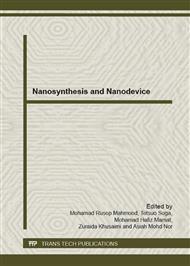[1]
V. A. Coleman and C. Jagadish, Basic Properties and Application of ZnO, in Zinc Oxide Bulk, Thin Films and Nanostructures, First ed, C. Jagadish and S. J. Pearton, Eds.: Elsevier, 2006, pp.1-20.
DOI: 10.1016/b978-008044722-3/50001-4
Google Scholar
[2]
M. H. Huang, S. Mao, H. Feick, H. Yan, Y. Wu, H. Kind, E. Weber, R. Russo, P. Yang, Room-Temperature Ultraviolet Nanowire Nanolasers, Science 292 (2001) 1897.
DOI: 10.1126/science.1060367
Google Scholar
[3]
Y. Tong, J. Cheng, Y. Liu, G. G. Siu, Enhanced photocatalytic performance of ZnO hierarchical nanostructures synthesized via a two-temperature aqueous solution route, Scripta Materialia 60 (2009) 1093-1096.
DOI: 10.1016/j.scriptamat.2008.12.060
Google Scholar
[4]
M. Gratzel, Mesoporous oxide junctions and nanostructured solar cells, Current Opinion in Colloid & Interface Science 4 (1999) 314-321.
DOI: 10.1016/s1359-0294(99)90013-4
Google Scholar
[5]
T. Terasako, M. Yagi, M. Ishizaki, Y. Senda, H. Matsuura, S. Shirakata, Growth of zinc oxide films and nanowires by atmospheric-pressure chemical vapor deposition using zinc powder and water as source materials, Surface & Coatings Technology 201 (2007).
DOI: 10.1016/j.surfcoat.2007.04.017
Google Scholar
[6]
H. W. Kim, M. A. Kebede, H. S. Kim, B. Srinivasa, D. Y. Kim, J. Y. Park, S. S. Kim, Effect of growth temperature on the ZnO nanowires prepared by thermal heating of Zn powders, Current Applied Physics 10 (2010) 52-56.
DOI: 10.1016/j.cap.2009.04.010
Google Scholar
[7]
Y. -H. Kang, C. -G. Choi, Y. -S. Kim, J. -K. Kim, Influence of seed layers on the vertical growth of ZnO nanowires, Materials Letters 63 (2009) 679–682.
DOI: 10.1016/j.matlet.2008.12.025
Google Scholar
[8]
E. Bacaksiz, S. Yilmaz, M. Parlak, A. Varilci, M. Altunbas, Effects of annealing temperature on the structural and optical properties of ZnO hexagonal pyramids, Journal of Alloys and Compounds 478 (2009) 367-370.
DOI: 10.1016/j.jallcom.2008.11.025
Google Scholar
[9]
Z. Khusaimi, M. H. Mamat, N. Abdullah, M. Rusop, ZnO Nanoparticles on Si, Si/Au, and Si/Au/ZnO Substrates by Mist-Atomisation, Journal of Nanomaterials 2012 (2012) Article ID 872856.
DOI: 10.1155/2012/872856
Google Scholar
[10]
A. Sugunan, H. C. Warad, M. Boman, J. Dutta, Zinc oxide nanowires in chemical bath on seeded substrates: Role of hexamine, J Sol-Gel Sci Techn 39 (2006) 49-56.
DOI: 10.1007/s10971-006-6969-y
Google Scholar
[11]
E. D. l. Rosa, S. Sepu´lveda-Guzman, B. Reeja-Jayan, A. Torres, P. Salas, N. Elizondo, M. J. Yacaman, Controlling the Growth and Luminescence Properties of Well-Faceted ZnO Nanorods, J. Phys. Chem. C 111 (2007) 8489-8495.
DOI: 10.1021/jp071846t
Google Scholar
[12]
Z. Khusaimi, S. Amizam, M. H. Mamat, M. Z. Sahdan, M. K. Ahmad, N. Abdullah, M. Rusop, Controlled Growth of Zinc Oxide Nanorods by Aqueous-Solution Method, Synthesis and Reactivity in Inorganic, Metal-Organic, and Nano-Metal Chemistry 40 (2010).
DOI: 10.1080/15533171003629147
Google Scholar
[13]
W. -J. Li, E. -W. Shi, W. -Z. Zhong, Z. -W. Yin, Growth mechanism and growth habit of oxide crystals, Journal of Crystal Growth 203 (1999) 186-196.
DOI: 10.1016/s0022-0248(99)00076-7
Google Scholar
[14]
L. Vayssieres, Advanced semiconductor nanostructures, C. R. Chimie 9 (2006) 691-701.
Google Scholar
[15]
H. W. Lee, S. P. Lau, Y. G. Wang, K. Y. Tse, H. H. Hng, B. K. Tay, Structural, electrical and optical properties of Al-doped ZnO thin films prepared by filtered cathodic vacuum arc technique, Journal of Crystal Growth 268 (2004) 596-601.
DOI: 10.1016/j.jcrysgro.2004.04.098
Google Scholar
[16]
R. Wahab, S. G. Ansari, Y. S. Kim, H. K. Seo, G. S. Kim, G. Khang, H. -S. Shin, Low temperature solution synthesis and characterization of ZnO nano-flowers, Materials Research Bulletin 42 (2007) 1640-1648.
DOI: 10.1016/j.materresbull.2006.11.035
Google Scholar
[17]
C. Chandrinou, N. Boukos, C. Stogios, A. Travlos, PL study of oxygen defect formation in ZnO nanorods, Microelectronics Journal 40 (2009) 296-298.
DOI: 10.1016/j.mejo.2008.07.024
Google Scholar
[18]
G. N. Karanikolos, P. Alexandridis, G. Itskos, A. Petrou, and T. J. Mountziaris, Synthesis and Size Control of Luminescent ZnSe Nanocrystals by a Microemulsion-Gas Contacting Technique, Langmui, 20 (2004) 550-553.
DOI: 10.1021/la035397+
Google Scholar
[19]
H. K. Yadav, K. Sreenivas, V. Gupta, S. P. Singh, R. S. Katiyar, Effect of surface defects on the visible emission from ZnO nanoparticles, Journal of Materials Research 22 (2007) 2404-2409.
DOI: 10.1557/jmr.2007.0321
Google Scholar
[20]
J. H. Cai, G. Ni, G. Hea, Z. Y. Wu, Red luminescence in ZnO films prepared by a glycol-based Pechini method, Physics Letters A 372 (2008) 4104-4108.
DOI: 10.1016/j.physleta.2008.03.011
Google Scholar
[21]
P. Jiang, J. -J. Zhou, H. -F. Fang, C. -Y. Wang, Z. L. Wang, S. -S. Xie, Hierarchical Shelled ZnO Structures Made of Bunched Nanowire Arrays, Advanced Functional Materials 17 (2007) 1303-1310.
DOI: 10.1002/adfm.200600390
Google Scholar
[22]
S. Yun, J. Lee, J. Yang, S. Lim, Hydrothermal synthesis of Al-doped ZnO nanorod arrays on Si substrate, Physica B 405 (2010) 413-419.
DOI: 10.1016/j.physb.2009.08.297
Google Scholar
[23]
J. Lee, J. Chun, S. Lim, Improvement of optical properties of post-annealed ZnO nanorods, Physica E 42 (2010) 2143-2146.
DOI: 10.1016/j.physe.2010.04.013
Google Scholar


